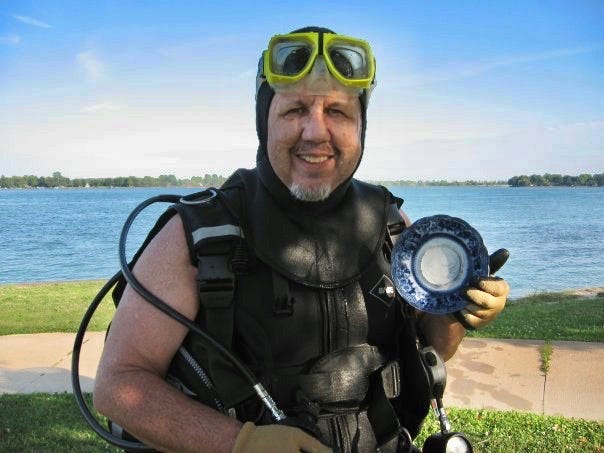Exploring what hides beneath the St. Clair River with Marko Tomko
A reprint of my article and my images.
Under the sparkling azure waters of the St. Clair River, lies the vast history of the Port Huron area. For centuries, the river has served as a conduit for travelers, from the Native Americans living in the region to the Europeans hoping to capitalize on its wealth. Marko Tomko is a diver of 39 years and has explored the river 750 times. He talks about his experiences and his findings of historical artifacts buried in the silt of this watery highway connecting Lake Huron to Lake St. Clair.
The history of the river stretches hundreds of years back. Local tribes traversed its waters via canoe, harvesting an abundance of fish including white fish and sturgeon, and farmed its fertile banks. Port Huron was a common meeting place with its centralized location and easy access. The indigenous people were replaced with Europeans who over four hundred years logged, trapped, fished, and industrialized the river.
Used as a shipping lane, the river has wrecked many boats due to its swift current and the region’s stormy weather. Many ship skeletons remain within buried in the river’s bottom. Trash from the settlers also lies below and paints a picture of how people lived during the period. Divers have flocked to the river over the years to seek these hidden treasures, including Tomko.
Marko began diving in 1985, when he and his wife went to a Club Med resort in the Bahamas, and he obtained a basic dive certification. Captivated by his experience, Marko returned to Michigan and received his Open Water Certification. He was drawn to the Sea Snoopers Diving Club, comprised of divers throughout southeast Michigan, and cultivated friendships and dive buddies to explore the Great Lakes.
One of Tomko’s favorite places to dive is the St. Clair River and 75% of his 1000 dives have been there. “The river is a great place for diving because it is easy and cheap to get to and there are neat things to find if you are inclined to look for them.” The river is close to his home and is low cost to explore, as a diver can gain access on the sides and does not have to hire a charter vessel. The river has good visibility and clear water on calm days and a quick call to the local water department can tell if the conditions are right. “I also like the fact that the river was a dumping ground for a couple of centuries and historic trash equal today’s historical artifacts.”
One of Tomko’s more challenging dives was near Marine City during the night. He forgot his corrective dive mask for his nearsightedness but dove anyways. When the light on his flashlight went out, he was plunged into darkness. He managed to find his way back using the faint glow of the city’s streetlights.
There are a multitude of shipwrecks under the river including the 63-foot steam powered tugboat called the Monarch, just 200 south of the Blue Water Bridge, and the John S. Martin, a 22- foot schooner carrying iron ore, on the north side of bridge.
One of Marko’s favorites is the M.E. Tremble, a three-mast schooner, that lies near the front of the Thomas Edison Inn. The Tremble is under 65 feet of water, in an area with very strong current, and in the shipping lane. Tomko will enter 50-75 yards upstream the shipwreck and get blown to it while pretending to swim. “I have to hang onto the wreck at all times, because the current will drag you off. It’s a bit like being in a very strong wind. Most divers who have experienced this dive agree that it is an advanced or “aggressive” dive.”
Over the years, Tomko has found many interesting artifacts including a .32 caliber pistol with a magazine with 3 rounds of ammunition wrapped in a purse near Algonac. “The pistol hadn’t been down there long and was in good working condition. It is now registered in my name with the police.” Another is a 12-inch-tall ceramic pitcher with a caramel “Rockingham” glaze from the 1860s, which was buried under 3 feet of silt. It is in very good condition. “So why was it dropped in the river? It’s a mystery and we will never know the answer, but it probably held some cool water for some ship building workers and got bumped over the side.” He has also recovered 1500s clay smoking pipes, coins, and logging tools.
When Tomko dives with his partner, they are greeted by small mouth bass. The bass eat crayfish and have learned that the divers will stir them up while digging for artifacts. The divers will also hand feed the fish. A few are very large with distinctive markings and have earned names. “The bass are a great source of delight to divers, because they hang around like puppy dogs.” The divers also see walleyes which are much more skittish, only appearing in the shadows, and are nicknamed the “ghost fish.”
This summer Marko turns 76 and is evaluating if he will continue diving. In the meantime, he dives the St. Clair River exclusively and waits till its waters are 70-72 degrees, which usually occurs around mid-June to July. “The warmer water temps make the diving easier and safer for an old fellow like me!”
To learn more about the history of the St. Clair River and see an underwater live camera feed of its depth, head to the Huron Lightship Museum next to the St. Clair River in Pine Grove Park in Port Huron. Designated a National Historic Landmark, the ship has an extensive collection of artifacts and includes many model ships.
.








